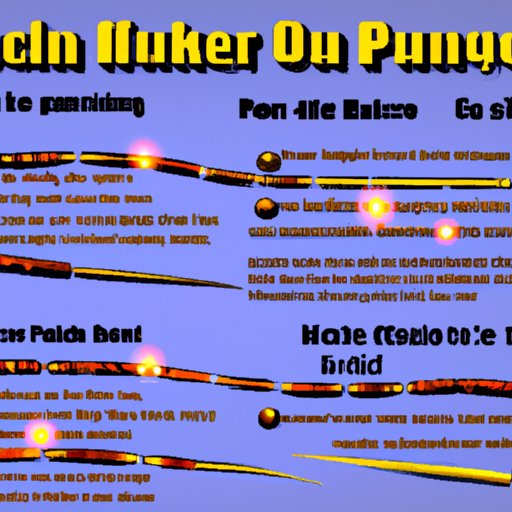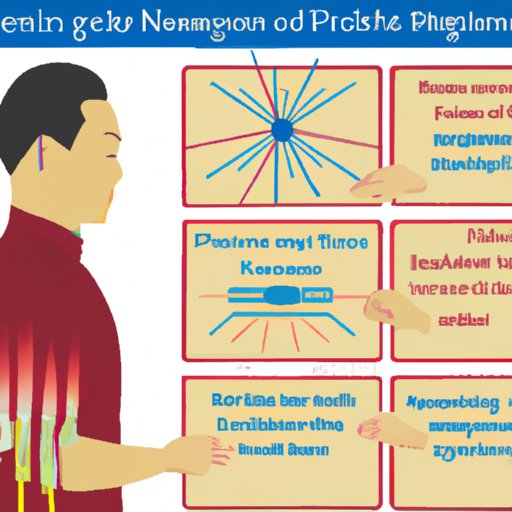Introduction
Pain relief is a common issue for many people, and over the centuries, various forms of alternative treatments have been used to alleviate symptoms. One such treatment is acupuncture, which has been practiced in traditional Chinese medicine for thousands of years. In this article, we will explore how acupuncture works to relieve pain and examine its effectiveness.

Exploring the Science of Acupuncture and How It Relieves Pain
Acupuncture is a form of alternative medicine that involves inserting thin needles into specific points on the body known as acupoints. According to traditional Chinese medicine, stimulating these points can help to restore balance in the body by restoring the flow of energy, or qi. This, in turn, can lead to a reduction in pain and other symptoms.
The traditional Chinese medicine perspective on acupuncture is based on the belief that the body is composed of a network of energy pathways, or meridians, that connect the organs and tissues. When qi is blocked or unbalanced, it can lead to physical and emotional problems, including pain. By stimulating the acupoints, practitioners aim to restore the balance of qi in the body, thus alleviating pain and other symptoms.
In addition to the traditional Chinese medicine perspective on acupuncture, there is also scientific evidence to suggest that it can be effective in relieving pain. Studies have shown that acupuncture stimulates the nervous system, which can cause the release of neurotransmitters such as endorphins, serotonin, and dopamine. These neurotransmitters act as natural painkillers and can help to reduce pain and inflammation.
Furthermore, acupuncture has also been shown to activate certain pain receptors in the body, which can help to reduce sensitivity to pain. Studies have found that acupuncture can increase the levels of adenosine in the body, which is a natural pain reliever. Acupuncture can also stimulate the production of nitric oxide, which helps to reduce inflammation and reduce pain.

A Guide to the Benefits of Acupuncture for Pain Management
Acupuncture can be used to treat a variety of types of pain, including back pain, neck pain, headaches, and menstrual cramps. It can also be used to treat chronic pain conditions, such as fibromyalgia, arthritis, and sciatica. In addition to being an effective form of pain relief, acupuncture can also provide other health benefits, such as improved sleep, reduced stress, and improved digestion.
Although acupuncture is generally considered safe, there are some potential risks and side effects associated with it. These may include nausea, fatigue, dizziness, and bruising at the site of the needle insertion. It is important to consult with a qualified practitioner before undergoing any form of acupuncture treatment.
Debunking Common Myths about Acupuncture and Its Effectiveness for Pain Relief
Despite its long history and growing popularity, there are still many misconceptions about acupuncture and its effectiveness for pain relief. For example, some people believe that acupuncture is a form of voodoo or witchcraft, or that it requires supernatural powers to be effective. However, these beliefs are unfounded and unsupported by scientific evidence.
In addition, there is a common misconception that acupuncture is only effective for treating musculoskeletal pain. While it is true that acupuncture can be used to treat pain associated with muscles and joints, it can also be effective in treating other types of pain, such as headaches and menstrual cramps.
To understand the efficacy of acupuncture for pain relief, it is important to look at the evidence-based research that has been conducted on the subject. A systematic review of studies published between 2000 and 2010 found that acupuncture was effective in reducing pain intensity and duration in patients with various types of pain, including low back pain, neck pain, and knee osteoarthritis. Another study published in 2019 showed that acupuncture was effective in reducing pain associated with cancer.
Conclusion
In conclusion, this article has provided an overview of how acupuncture works to relieve pain, and the evidence supporting its effectiveness. Acupuncture is a form of traditional Chinese medicine that works by stimulating specific points on the body to restore the balance of qi and reduce pain. Studies have also shown that acupuncture can stimulate the nervous system and activate certain pain receptors, leading to a reduction in pain and inflammation. Furthermore, acupuncture can be used to treat a variety of types of pain, including back pain, neck pain, headaches, and menstrual cramps. Finally, it is important to note that there are some potential risks and side effects associated with acupuncture, so it is important to consult with a qualified practitioner before undergoing any type of treatment.
If you are suffering from chronic pain or are looking for alternatives to traditional pain medications, then acupuncture may be worth considering. With its long history of use and growing evidence of its effectiveness, acupuncture can be a safe and effective form of pain relief for many people.
(Note: Is this article not meeting your expectations? Do you have knowledge or insights to share? Unlock new opportunities and expand your reach by joining our authors team. Click Registration to join us and share your expertise with our readers.)
